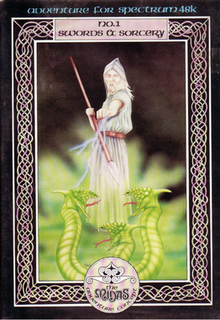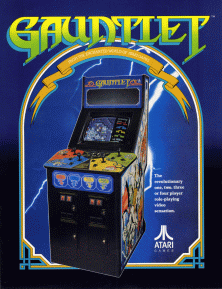
Gauntlet is a 1985 fantasy-themed hack-and-slash arcade video game developed and released by Atari Games. It is one of the first multiplayer dungeon crawl arcade games. The core design of Gauntlet comes from 1983 game Dandy for the Atari 8-bit computers, which resulted in a threat of legal action. It also has similarities to the action-adventure maze video game Time Bandit (1983).

Barbarian: The Ultimate Warrior is a 1987 video game developed and published by Palace Software for the Amstrad CPC, Commodore 64, and ZX Spectrum. The game was ported to many other systems and was licensed to Epyx who published it as Death Sword in the United States.

Theatre Europe is a turn-based strategy video game developed and published by Personal Software Services (PSS). It was first released in the United Kingdom for the Commodore 64, ZX Spectrum, Amstrad CPC, and Atari 8-bit computers in 1985. It was later released in France by ERE Informatique in 1986, and was released in the United States by Datasoft later that year. A port for the Tatung Einstein was released in 1989, in the UK. It is the fifth installment of the Strategic Wargames series.

Gunfright is an action-adventure game developed by Ultimate Play the Game and published by U.S. Gold. It was first released for the ZX Spectrum in December 1985, then released for Amstrad CPC and the MSX the following year. The player takes the role of a sheriff in the town of Black Rock and is tasked with eliminating outlaws who are scattered throughout the settlement.

Tornado Low Level is a multidirectional flight game developed by Costa Panayi and published in 1984 by the company he co-founded, Vortex Software. The game was first released for the ZX Spectrum, and later ported to the Amstrad CPC and Commodore 64.
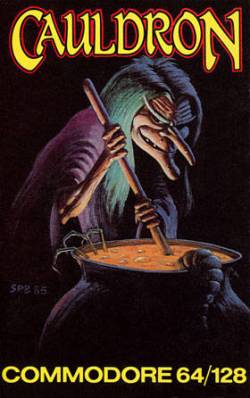
Cauldron is a video game developed and published by British developer Palace Software in 1985 for the ZX Spectrum, Commodore 64, and Amstrad CPC home computers. It contains both platform game and horizontally scrolling shooter sections. Players control a witch who aims to become the "Witch Queen" by defeating an enemy called the "Pumpking".
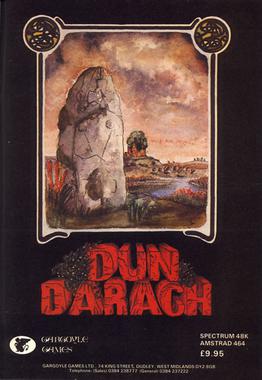
Dun Darach is an arcade adventure developed and published in 1985 by Gargoyle Games for the ZX Spectrum and Amstrad CPC computers. It is a prequel to the 1984 game Tir Na Nog. The plot has Celtic hero Cuchulainn on a search to find his companion Lóeg in the mysterious city of Dun Darach. Inspiration for the game came from the works of Fritz Leiber and Michael Moorcock.

Navy SEALs is a shoot 'em up platform video game developed and published by Ocean Software. It was first released in the United Kingdom for the Amstrad CPC, Amstrad GX4000 and Commodore 64 in 1990. It was later re-released in the rest of Europe for the ZX Spectrum, Atari ST and Amiga home computers in the following year. It was then ported to the Game Boy on 1 September 1991 in the United States. The game is based on the film of the same name and follows the protagonist, Lieutenant Dale Hawkins, progressing through five side-scrolling levels.

Cauldron II: The Pumpkin Strikes Back is a video game developed and published by British developer Palace Software as a sequel to their 1985 game Cauldron. The 2D platform game was released in 1986 for the ZX Spectrum, Commodore 64, and Amstrad CPC home computers. Players control a bouncing pumpkin that is on a quest of vengeance against the "Witch Queen". The roles of the two were reversed from the first game, in which the witch defeated a monstrous pumpkin.
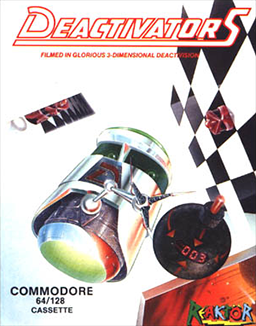
Deactivators is a 1986 puzzle video game designed by David Bishop and Chris Palmer, developed by Tigress Marketing and System Software, and published by Ariolasoft's action game imprint Reaktor. The player controls bomb disposal robots known as deactivators and must use them to deactivate bombs planted by terrorists in five research complexes. The concept for the game came from a brainstorming session between Bishop and Palmer; its design and development took five to six months to complete. It was released for the Amstrad CPC 464, Commodore 64, and ZX Spectrum platforms in October 1986.

Barbarian II: The Dungeon of Drax is a video game first published in 1988 for various home computers. It was released as Axe of Rage in North America. The game is the sequel to Barbarian: The Ultimate Warrior, which was published in 1987. In Barbarian II, the player controls a princess or barbarian character, exploring the game world to locate and defeat an evil wizard. The game's plot is an extension of its predecessor, although the gameplay is different. While the first game offers two players the opportunity for virtual head-to-head combat, the second is a single-player beat 'em up with fewer fighting moves. It uses a flip-screen style instead of scrolling.

Battle of Britain is a turn-based strategy video game developed and published by Personal Software Services for the Commodore 64 in 1985. It was also ported to the Amstrad CPC and ZX Spectrum the next year. It is the seventh instalment to the Strategic Wargames series. The game is set during the Battle of Britain campaign of the Second World War and revolves around Britain's defence and prevention against a Nazi invasion. In the game, the player commands the Royal Air Force as they must defend key cities against the Luftwaffe.

Light Force is a 1986 vertically scrolling shooter designed by Greg Follis and Roy Carter, developed by their company Gargoyle Games, and published under their Faster Than Light imprint. It was released for the Amstrad CPC, Commodore 64, and ZX Spectrum platforms.

Zoids: The Battle Begins is a 1986 video game designed by Chris Fayers, developed by the Electric Pencil Company, and published by Martech. and released in Europe for the ZX Spectrum, Amstrad CPC, MSX and Commodore 64 computers. Based on the Zoids toy series, the player controls a human who was fused with one of the robots and has to reclaim parts of a larger mech.

Falklands '82 is a 1986 turn-based strategy video game developed and published by Personal Software Services for the ZX Spectrum and Commodore 64. It is the fifth instalment of the Strategic Wargames series. The game is set during the 1982 Falklands War and revolves around the Argentine occupation and subsequent British re-capture of the Falkland Islands. The player controls the British Task Force as they must either defeat all Argentine forces on the archipelago or re-capture every settlement.

Battlefield Germany is a turn-based strategy video game developed and published by Personal Software Services for the Commodore 64 released in April 1987. It was also ported to the Amstrad CPC and ZX Spectrum later that year. It is the eighth instalment to the Strategic Wargames series. The game is set during a fictional scenario in which the powers of NATO and the Warsaw Pact engage in a conventional war throughout Europe, mostly centring in West and East Germany.
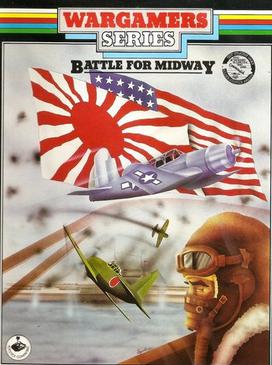
Battle for Midway is a turn-based strategy video game developed and published by Personal Software Services. It was first released in the United Kingdom and France for the MSX in 1984, and was re-released for the Amstrad CPC, Commodore 64 and ZX Spectrum in 1985. It is the second instalment of the Wargamers series. The game is set during the Battle of Midway in the Pacific Ocean theatre of World War II and revolves around the United States Navy attacking a large Imperial Japanese fleet stationed at Midway Atoll, in retaliation for the attack on Pearl Harbor.

Ace is a combat flight simulator video game published for the Commodore 64, VIC-20, and Plus/4 in 1985 by Cascade Games. It was ported to the Amstrad CPC, Amstrad PCW, Amiga, and ZX Spectrum.

Throne of Fire is an action strategy video game. It was designed by Mike Singleton, developed by Consult Computer Systems, and published by Melbourne House. The game was released for the Amstrad CPC and ZX Spectrum in 1987. Throne of Fire is set in the Burning Citadel, located around the rim of a volcano.

Yes, Prime Minister is a 1987 adventure game based on the television series of the same name. It was developed by Oxford Digital Enterprises and published by Mosaic Publishing. It was released in Europe for Amstrad CPC, BBC Micro, Commodore 64, DOS, and ZX Spectrum. Critics found it a faithful adaptation of the television series, but remarked on its high price, short length, and lack of long-term appeal.
